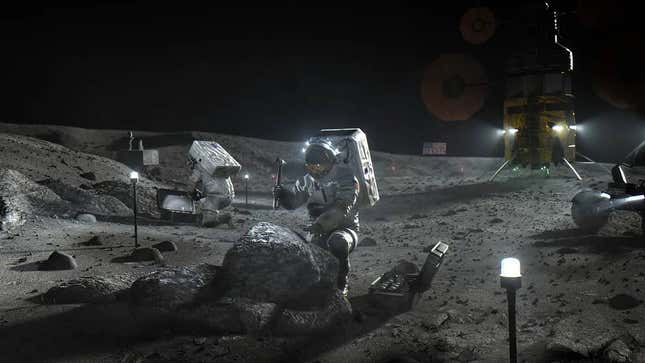NASA and its international partners have big plans when it comes to the Moon—plans that will require the careful synching of Earth-based clocks with those on the Moon. The White House wants NASA to develop a solution to support the Artemis program, but to also maintain the United States’ leading position in the global space race.
The plan, first reported by Reuters, is for the U.S. space agency to develop Coordinated Lunar Time (LTC) by the end of 2026. Coordinating time systems on Earth is a relatively easy task, but due to relativity, it’s considerably more challenging once the Moon becomes involved.
Advertisement
Due to Einsteinian relativity, time passes differently on the Moon than it does on Earth. The same can be said for space in general. Time—or at least its perception—would slow down significantly if you were near a black hole because of the object’s intense gravitational pull. The difference between how time passes on the Moon versus the Earth is very slight, but it adds up.
Advertisement
The White House’s direction is not without precedent. Last year, ESA opened applications for companies to help it develop a standardized Moon clock. NASA launched its Deep Space Atomic Clock (DSAC) in 2019, to allow spacecraft to better navigate independent from communiques from Earth.
Advertisement

Missions to the Moon currently communicate with team members on Earth using coordinated universal time (UTC) as a common temporal language. UTC’s timing is tied to an ensemble of atomic clocks. In fact, UTC is only one coordinated universal time scale; you can read about different types of universal time (and their many acronyms and initialisms) here. But as humans prepare to have a semi-permanent presence on our rocky satellite, space agencies have determined a need for a separate time system, to address the fact that a clock on the Moon would run slightly faster than a clock on Earth.
Advertisement
One expert told Nature that a lunar clock would gain about 56 microseconds over the course of an Earth day. (The White House’s Office of Science and Technology estimated a loss of 58.7 microseconds per day.) If humans on the Moon operated with normal clocks, they would completely desynchronize from Earth time.
The White House’s timing lines up with the timing of the Artemis program, which will see NASA astronauts return to the lunar surface. Artemis 3 seeks to land a human crew in the vicinity of the lunar south pole no earlier than 2026.
Advertisement
The return-to-space-race, if you will, is made up of many sprints, across several fields of engineering and space science. One of the sprints is the race to define time itself, and the White House just told its athlete to start running. As to how Russia, China, or other nations will respond to this seemingly unilateral action, that remains an open question.
More: We Need Moon Standard Time
Services Marketplace – Listings, Bookings & Reviews